by Cristoforo Sergio Bertuglia* and Franco Vaio**
* Former Professor of Urban and Regional Planning, Turin Polytechnic;
cristoforo_sergio_bertuglia@yahoo.it
** Former Professor of Mathematical Models for Applications, Turin Polytechnic;
This essay has been published in Italian and English in Volume XXXII «The City Crisis – The Priority of the XXI century ... for a “UN World Conference” ... for a “UN Resolution”», Eighth Tome, edited by Corrado Beguinot, Giannini, Napoli, 2011, Series «Studi Urbanistici» of the Fondazione Aldo Della Rocca (www.fondazionedellarocca.it). The Volume was presented at the International Conference on the Inter-ethnic City, Rome, Campidoglio, June 2011 with the participation of the Secretary of the United Nations: Ban Ki-moon; and at the Round table «The inter-ethnic city: management and policies for a better integration of migrants», organized by the Permanent Representatives of Italy and Canada to the UN, with the Alliance of Civilizations and the International Organization for Migration, New York, September 2011.
Introduction
In recent decades the city has come to be viewed as a complex system. At the same time, every city interacts with other cities, as is natural in our globalized world: every city is part of a network of cities, which in turn is also viewed as a complex system.
The complexity approach has inspired new methodologies for urban studies, including cellular automata and agent-based models. These new models are much simpler than the traditional ones in terms of the mathematical techniques employed, yet they have succeeded in accounting for phenomena that previously defied explanation.
Schelling’s model explains the appearance of urban segregation
One of the first models to use the new concepts of cellular automaton and agent was designed by Thomas Schelling at the end of the 1960s to explain the appearance of racial segregation and urban ghettoes.
Schelling’s model considers an abstract, closed territory divided into square cells inhabited by two populations, one white, the other black, scattered over the territory. Some cells are empty, others are inhabited by one individual, either black or white. Each individual is considered an agent, i.e. a person who is autonomous in his choices and decides his behaviour individually in relation to the situation in which he finds himself: in short, an individual/agent (often rendered simply as “individual” in what follows).
The evolution of the system described by Schelling is determined by the fact that each individual/agent singly and autonomously decides whether or not to move from the cell he occupies to the nearest vacant cell. The decision is taken on the basis of a single rule: a weak individual preference for persons of the same colour. In fact, an individual will decide to move only if fewer than one third of his neighbours in the adjacent cells have his own skin colour (Figure 1).
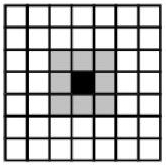
Figure 1 Schelling’s model. In grey, the part of the urban territory that the inhabitant of a cell (shown in black) considers in counting his neighbours with his skin colour and those with the other colour.
If someone moves, this influences the subsequent decisions both of the individual’s new neighbours and the neighbours of the abandoned cell. This is because both the former and the latter experience a change in the ratio of the number of neighbours of their skin colour to that of the other colour.
As a consequence of the relocation, it is possible that other individuals who had been satisfied with their situation are no longer satisfied and decide, in turn, to move. The variations in the situations of new and old neighbours can generate new relocations, and so forth.
The series of relocations triggered by the mechanism we have described produces startling results. Over time, the model moves from an initial configuration in which the cells were randomly distributed to one in which cells of the same colour are gathered together in large, homogeneous clusters. It is in this way that ghettoes are formed. More in general, if the cells of one colour initially alternated with those of the other colour, like a chessboard, no one will move, because exactly half of each individual’s neighbours have his skin colour. But if we introduce a few local perturbations in the “chessboard” by changing the colour of a few cells scattered here and there (Figure 2, left), relocations ensue and the system begins to evolve.
The model shows that the disequilibrium introduced triggers the dynamics of segregation and the formation of ghettoes (Figure 2, right).
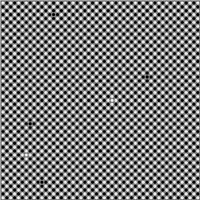
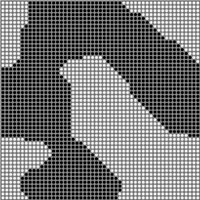
Figure 2 Schelling’s model. Starting from a uniform distribution of cells in which a few local perturbations are introduced (left), the system evolves towards segregation (right).
Schelling’s model implies some surprising conclusions. Interaction among individual choices leads to collective results that do not strictly depend on individuals’ intentions. In fact, no individual seeks to institute a segregated arrangement, but even when individuals are tolerant enough to accept living in an integrated situation, that situation is unstable. And even if persons move only when they are locally surrounded to a significant degree by individuals of the other colour, in this context of instability they trigger the process of spatial segregation.
It is fundamental to observe that spatial segregation is generated even when the individual preferences underlying the relocation decisions are weak and individuals are only interested in their next-door neighbours.
Schelling thus showed that ghettoes appear as an unpredictable phenomenon, not as the result of a conscious choice by the individuals who create them or of outside imposition. They arise in an entirely unexpected way from the rules that govern the dynamics of the system. This is why the phenomenon is described as “emergent”.
In conclusion, Schelling showed that the formation of ghettoes is the outcome of an internal process of organization of the system, which originates from individual location choices: the self-organization – spatial in this case – of the system. More in general, Schelling showed that the social, economic and spatial system has the ability to organize itself, and that this self-organization can be the unexpected outcome solely of the internal rules governing the functioning of the system.
FROM SOCIETY AS MACHINE TO SOCIETY AS ORGANISM
In the mid-twentieth century, society was widely conceived to be a machine-like system, with mechanically interconnected parts.
The metaphor of society as a machine disregarded individuals’ freedom of choice, and its application to social, economic and territorial systems often produced poor results.
Over the last few decades that metaphor has been steadily abandoned in favour of an approach that conceives of social, economic and territorial systems – cities, say – not as mechanical systems to be rebalanced but as organisms physiologically in disequilibrium owing to the continuous flows to which they are subjected.
Social, economic and territorial systems, and particularly urban systems, are found to have numerous subsystems – lower-level self-organizational structures – both in the spatial dimension, viz. Schelling, and in the social and economic dimensions.
Urban systems, in turn, are self-organized subsystems of vaster systems, or macrosystems, in which the interactions between the parts are so close that they determine the formation of macroareas within the macrosystem. The behaviour of these macrosystems is relatively autonomous with respect to other macroareas, following dynamics that are specific to them and that make them easily identifiable.
These various self-organizational structures are present at different levels: the level of city networks, that of the individual city taken in its totality, and that of the different elements that compose the city, e.g. the transport network, the real estate market, the flows of persons and goods to the different time-space scales. They behave like individuals in interaction with other self-organizational structures which also behave like individuals/agents, all of them belonging to a vaster macrosystem. Their interaction originates processes guided only by internal rules, which lead to a self-organization (accordingly called endogenous) extending to many levels or dimensions.
THE NEW CONCEPTION OF URBAN SYSTEMS AS COMPLEX SYSTEMS
It follows that cities are no longer seen as planned artifacts, but as complex multidimensional systems that evolve as a consequence of spontaneous and endogenous dynamics: systems characterized, as also happens for living beings, by the continual, spontaneous and endogenous breaking down and formation of structures – in this case, social, economic and physical-spatial structures.
To understand the self-organizational dynamic of urban systems, it is essential to bear certain points in mind:
- the interactions between individuals are nonlinear forms, i.e. they are characterized by the fact that there is no direct proportionality between cause and effect;
- the information that individuals possess is always incomplete and generally differs from one individual to another;
- mental processes differ from one individual to another;
- the knowledge that individuals extract from information differs from one individual to another, both because the information they have differs and because individuals, with their differing mental processes, can draw different conclusions from the same information;
- each individual is an agent who “adapts” to the surrounding world with which he interacts;
- as a consequence of adaptation, each agent, accumulating experience and seeking to improve the outcomes of his actions, forms and continually modifies his own internal rules of behaviour according to his own individual point of view.
All these elements are extraneous to the interpretative schema of neoclassical economics, based on the idea of a rational, omniscient and standardized homo oeconomicus.
Cities – small or large – must therefore be viewed as complex systems. This means that while their evolution can be accompanied and assisted by appropriate planning measures, they can never be exclusively the object of central or top-down planning.
The study of appropriate modeling under the complexity approach points towards an interpretative framework that views the urban system as being activated from the bottom up, in a process in which endogenous mechanisms tied to individuals’ choices are at work.
In the last thirty years the complexity approach has proven most effective in describing, interpreting and fully understanding numerous phenomena in both the natural and social sciences. Complexity develops within the sphere of the preceding systemic vision of the phenomena, but is distinguished by its particular attention to the fact that a complex system is characterized by nonlinear interactions among its constituent elements and continuous actions of the system on the outside world with which it is in contact, the environment.
There are uninterrupted flows of various kinds from the system to the environment, and the system receives environmental feedback in return.
The nonlinear nature of the interactions, the environmental feedback and the continual flows, owing to which the system is perennially in a state of disequilibrium, generate unexpected emergent phenomena and forms of self-organization.
The characteristics we have used to define a complex system are usually summed up with the saying that “the whole is greater than the sum of its parts”.
The new conception has proven especially useful in the social sciences, whose methods of inquiry have found complexity to be a powerful and effective interpretative framework. In particular, the new approach has benefited the study of urban systems.
In that context, the phenomena observed are not described as a series of isolated facts, but as the spontaneous manifestation of properties implicit in the interactions of the system’s elements and therefore specifically characterizing that system.
A MODEL OF THE DYNAMICS OF THE ENGLISH URBAN HOUSING MARKET
We now briefly discuss the agent-based model of the dynamics of the English urban housing market developed by Gilbert and others in 2009. The basic idea is that in order to reproduce the characteristics of the English urban housing market it is sufficient to consider the interactions between three types of agent: sellers, buyers and realtors. Nothing else is needed. In fact, the model does not take into account the features of the individual housing units or their spatial attributes, such as distance to the urban centre or proximity to facilities, nor does it distinguish between rich and poor neighbourhoods. Prices are the only information that agents exchange, and they alone determine agents’ decisions and the transaction prices. (As noted earlier, agents are individuals capable of making autonomous decisions who choose in relation to the behaviour of other agents but not necessarily in the same way as other agents.) As in Schelling’s model, we have emergent phenomena. In this case they are of a social, economic and spatial nature and originate exclusively from the interactions between the three types of agent.
The city is represented by a matrix of cells, each a housing unit. Starting from the random distribution of the initial valuations of housing prices (Figure 3, left, where the colour of the cell indicates the initial valuation), applying the model may lead to the formation of areas in which house prices tend to converge at high levels.
This is shown in Figure 3, right, where we see that an area of mainly blue cells (high prices) has formed in the centre of the city. That area takes shape, we emphasize, not because the model initially considers the city centre as more desirable and hence more expensive, but as an emergent phenomenon in a complex system – the outcome of the dynamics generated solely by interaction among the agents.
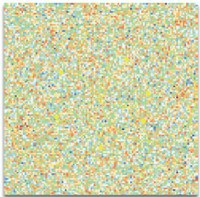
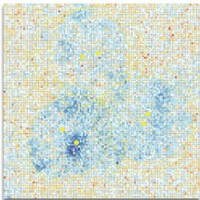
Figure 3 The model of Gilbert et al. Starting from a random distribution of house price valuations (left), the model shows the formation of a central area of high-priced housing (right).
The phenomenon in question can thus be produced in the total absence of the causes that are ordinarily adduced to explain the formation of high house prices in city centres: causes that are certainly reasonable but that, as the model demonstrates, are not necessary. The surprising result does not consist in the formation of a central area of expensive housing, a well-known phenomenon, but in the identification of interaction between individuals as the potential sole cause of that phenomenon. No previous study has ever posited this as a single cause. More in general, the work of Gilbert et al. confirms the underlying idea that the market itself is a complex system, one whose overall dynamics are the unpredicted and unpredictable endogenous outcome of nonlinear interactions between agents who continuously exchange information.
CONCLUSION: THE BASIC CONCEPTS OF COMPLEXITY IN ECONOMICS
The concepts of feedback and emerging phenomenon are not entirely foreign to the tradition of neoclassical economics.
As far as feedback is concerned, in a certain sense the theory of general economic equilibrium is a formalization of the proposition: “In economics, everything influences everything else”.
The concept of emergent phenomenon – a collective phenomenon that cannot be predicted on the basis of the individual elements of the system – has been part of economics for some time. An example is the economic cycle, in which all agents interact nonlinearly, receive feedback and originate a collective phenomenon independent of their individual intentions.
Adam Smith’s invisible hand itself has the characteristics of an emergent phenomenon: the market, set in motion by individual interests, acts “as if” an invisible hand guided it towards the realization of collective wellbeing. It is precisely the “as if” that makes the invisible hand an emerging phenomenon. The invisible hand is not an entity internal or external to the system. For Adam Smith, the economic system evolves from the bottom up, as the consequence solely of the decisions of individual agents, but it behaves globally “as if” it were guided by an invisible hand, which in reality does not exist.
The concept of self-organization of a system appears more rarely in traditional economic theory (so-called mainstream economics), but current scientific research is paying increasing attention to the role of nonlinear interactions among the components of a system in disequilibrium. These interactions are at the origin of self-organization: this is the focal point of the complexity approach.
In this new approach, the dynamics of the economic system are therefore seen as the product of a network of nonlinear interactions among the parts of the system, not the simple sum of the dynamics of the system’s individual components taken one by one, as posited in traditional economic theory.
The complexity approach treats the system as an indivisible unit that cannot be reduced to the sum of the individual behaviours of its component parts. This is highly promising for our comprehension of social, economic and territorial phenomena that are not captured by traditional analytical methods and perspectives.
––––––––––––––––
Bibliography
Bertuglia, C.S., and F. Vaio. Non linearità, caos, complessità. Le dinamiche dei sistemi naturali e sociali. Turin: Bollati Boringhieri, 2003 [2nd edition revised and expanded, 2007]. English edition: Nonlinearity, Chaos and Complexity. The Dynamics of Natural and Social Systems. Oxford: Oxford University Press, 2005.
Bertuglia, C.S., and F. Vaio. Complessità e modelli. Un nuovo quadro interpretativo per la modellizzazione nelle scienze della natura e della società. Turin: Bollati Boringhieri, 2011.
Gilbert, N., J.C. Hawksworth and P. Swinney. “An Agent-based Model of the English Housing Market”. CRESS – Centre for Research in Social Simulation, University of Surrey; Proceedings of the AAAI Spring Symposium, Stanford, California, http://www.aaai.org/Papers/Symposia/Spring/2009/SS-09-09/SS09-09-007.pdf.
Schelling, T.C. Micromotives and Macrobehavior. New York: Norton, 1978.


